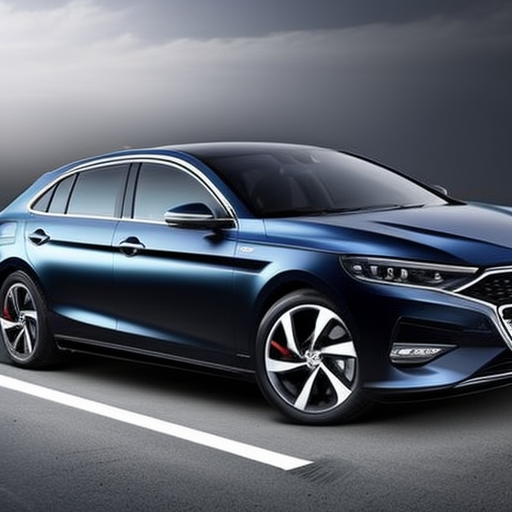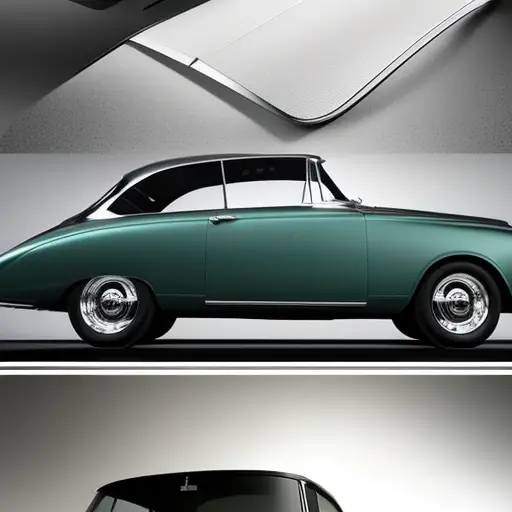The Impact of Aerodynamics on Car Performance

As cars slice through the air, the interplay between aerodynamics and performance becomes a critical factor. The intricate dance of air over and around a vehicle influences speed, acceleration, and fuel efficiency.
In this article, we delve into the historical evolution of aerodynamics in cars, explore the factors shaping aerodynamic performance, and examine the latest design innovations.
Join us as we unravel the pivotal role of aerodynamics in shaping the driving experience of the future.
Historical Perspective on Aerodynamics in Cars
The historical perspective on aerodynamics in cars dates back to the early 20th century when automotive engineers began recognizing the potential impact of air resistance on vehicle performance. This realization led to a series of historical advancements in the field of aerodynamics, particularly in the context of racing.
Engineers and designers sought to minimize air resistance and harness the potential benefits of aerodynamics to enhance the speed and stability of racing cars. Notably, during the 1920s and 1930s, streamlined body designs and other aerodynamic innovations started to emerge in the racing world, marking the first deliberate efforts to optimize vehicle aerodynamics for performance.
Aerodynamics in racing became a critical factor in gaining a competitive edge, and this drove further developments in the discipline. The quest for higher speeds and better handling pushed engineers to explore new aerodynamic principles and technologies, leading to significant breakthroughs in vehicle design. These historical advancements laid the foundation for modern aerodynamic principles in automotive engineering, shaping the way cars are designed and optimized for performance today.
Transitioning into the subsequent section, it is important to delve into the factors influencing aerodynamic performance in contemporary vehicles.
Factors Influencing Aerodynamic Performance
Transitioning from the historical perspective, designing contemporary vehicles for optimal aerodynamic performance involves considering a range of influential factors. The influence of design on aerodynamic performance is paramount, with vehicle shape, surface texture, and component integration playing pivotal roles. The design process incorporates computational fluid dynamics (CFD) simulations and wind tunnel testing to analyze and optimize airflow around the vehicle.
Additionally, the shape of the car, including the front grille, rear spoiler, and underbody panels, significantly impacts aerodynamics. Wind tunnel testing allows engineers to measure the forces acting on the vehicle due to airflow and refine its design to minimize drag and lift forces. Furthermore, the integration of aerodynamic features, such as diffusers and air curtains, is carefully considered to enhance the vehicle’s overall aerodynamic efficiency.
Understanding these factors is crucial for achieving the desired balance between drag reduction and high-speed stability, thereby improving the overall performance of the vehicle.
This intricate understanding of the factors influencing aerodynamic performance directly correlates with the role of aerodynamics in speed and acceleration.
The Role of Aerodynamics in Speed and Acceleration
Aerodynamics plays a crucial role in determining the speed and acceleration of a car. The interaction between the vehicle and the surrounding air affects the overall performance through the generation of aerodynamic forces.
Understanding the impact of air resistance on speed and acceleration is essential for optimizing the design and performance of a car.
Aerodynamics and Speed
When optimizing a car’s aerodynamics, engineers primarily focus on enhancing speed and acceleration through the reduction of drag and lift forces. By reducing drag, the air resistance that acts against the vehicle’s forward motion is minimized, allowing for higher speeds. Additionally, controlling lift forces is crucial for maintaining stability at high speeds, which directly impacts acceleration capabilities.
The design of aerodynamic components such as spoilers, diffusers, and splitters play a critical role in managing airflow to reduce drag and lift forces, thus improving the overall speed and acceleration performance of the vehicle.
Furthermore, aerodynamics also influences handling characteristics during high-speed cornering, where the manipulation of airflow around the car affects its stability and traction. Understanding the intricate relationship between aerodynamics and speed is essential for maximizing a car’s performance potential.
This seamless integration of aerodynamic efficiency is essential in optimizing a vehicle’s speed and acceleration, directly influencing its overall performance. In the subsequent section, we will delve into the critical relationship between acceleration and air resistance.
Acceleration and Air Resistance
The optimization of a car’s aerodynamics significantly influences its acceleration by minimizing air resistance, thereby enhancing its speed and performance.
When a car accelerates, it has to overcome the drag forces caused by air resistance. Aerodynamic design plays a crucial role in reducing this resistance, allowing the vehicle to achieve higher speeds more efficiently.
By shaping the car to minimize drag and turbulence, engineers can improve its acceleration capabilities. This is achieved through careful design of the car’s body, including the shape of the front grille, underbody panels, and spoilers.
Additionally, reducing air resistance can result in improved fuel efficiency, as the engine doesn’t have to work as hard to propel the vehicle forward. Therefore, aerodynamics directly impacts a car’s acceleration and overall performance.
Impact of Aerodynamics on Fuel Efficiency
The impact of aerodynamics on fuel efficiency is a crucial aspect of vehicle performance.
Drag and fuel consumption are closely linked, with higher drag resulting in increased fuel consumption.
Streamlined shapes are known to reduce drag, thus improving fuel efficiency.
Consequently, aerodynamic design plays a significant role in saving fuel and optimizing overall vehicle performance.
Drag and Fuel Consumption
Aerodynamics significantly affects a vehicle’s fuel efficiency through its impact on drag. Drag reduction plays a crucial role in minimizing the energy required to propel a vehicle, thereby enhancing fuel efficiency.
By optimizing the vehicle’s aerodynamic design, drag can be reduced, resulting in decreased resistance to the vehicle’s forward motion. This reduction in drag leads to improved engine efficiency as the power required to overcome aerodynamic resistance is reduced. Consequently, the engine can operate more efficiently, consuming less fuel for a given level of performance.
Thus, the interplay between aerodynamics, drag reduction, and engine efficiency directly influences a vehicle’s fuel consumption, highlighting the pivotal role of aerodynamics in enhancing fuel efficiency and reducing environmental impact.
Streamlined Shapes Reduce Drag
To optimize fuel efficiency, implementing streamlined shapes is essential in minimizing drag and enhancing a vehicle’s aerodynamic performance. This is achieved through meticulous wind tunnel testing, allowing engineers to fine-tune the vehicle’s shape for reduced air resistance.
Additionally, the use of advanced aerodynamic materials further contributes to this goal. These materials are chosen for their ability to reduce turbulence and streamline the airflow around the vehicle, ultimately decreasing drag.
When combined with precision engineering, such materials enable the creation of vehicles with significantly improved fuel efficiency. In essence, the integration of streamlined shapes and aerodynamic materials plays a pivotal role in enhancing a vehicle’s overall aerodynamic performance, leading to reduced drag and improved fuel efficiency.
Aerodynamic Design Saves Fuel
Implementing aerodynamic design significantly impacts fuel efficiency, enhancing the overall performance of cars. Fuel saving techniques are integral to modern car design, with aerodynamic efficiency playing a crucial role.
By reducing aerodynamic drag, vehicles can achieve better fuel economy. Streamlined shapes, underbody panels, and active grille shutters are among the many design elements that contribute to improved aerodynamics, thus reducing the energy required to propel the vehicle through the air.
Additionally, advancements in materials and manufacturing processes have allowed for the development of smoother surfaces and more intricate aerodynamic features, further enhancing fuel efficiency.
As car manufacturers continue to prioritize aerodynamic design, the industry is likely to see even greater gains in fuel economy, ultimately benefiting both consumers and the environment.
Aerodynamics and Vehicle Stability
The role of aerodynamics in maintaining vehicle stability is crucial for enhancing overall performance and safety on the road. Aerodynamics plays a significant role in influencing vehicle handling and cornering performance, ultimately contributing to the stability of the vehicle. This is achieved through several key mechanisms:
-
Downforce: Aerodynamically designed vehicles generate downforce, which is a vertical force that pushes the tires onto the road surface. This helps to increase traction, allowing the vehicle to navigate corners more effectively and maintain stability at higher speeds.
-
Drag Reduction: By minimizing aerodynamic drag, vehicles can maintain better stability, especially when traveling at high speeds or during sudden maneuvers. Reduced drag decreases the tendency for the vehicle to be affected by external factors such as crosswinds, thereby enhancing stability and control.
Aerodynamics and vehicle stability are critical aspects that are intricately linked, and understanding the impact of aerodynamic design on these elements is essential for optimizing vehicle performance and ensuring safe handling, especially during dynamic driving conditions.
Aerodynamic Design Innovations in Modern Cars
Aerodynamic design innovations in modern cars directly impact their stability and performance on the road, with advancements in shaping and airflow management contributing to enhanced handling and efficiency. This is achieved through meticulous engineering and testing. Wind tunnel testing plays a crucial role in refining the aerodynamic profile of vehicles. It allows engineers to analyze the airflow over the vehicle’s body, enabling them to make precise adjustments to reduce drag and improve downforce. Moreover, material selection is pivotal in modern aerodynamic design. Lightweight yet sturdy materials such as carbon fiber composites are increasingly being utilized to construct car bodies, contributing to reduced weight and improved aerodynamic performance. The table below illustrates the evolution of aerodynamic design in modern cars.
| Aerodynamic Design Innovations |
|---|
| Advanced shaping techniques |
| Streamlined body panels |
| Underbody airflow management |
| Wind tunnel testing |
| Material selection |
As automotive technology continues to advance, aerodynamic design innovations will play an increasingly prominent role in shaping the future of car performance and efficiency.
Future Trends in Automotive Aerodynamics
Advancements in shaping and airflow management will continue to drive future trends in automotive aerodynamics, directly influencing the stability and performance of vehicles on the road. The future of automotive aerodynamics will be shaped by cutting-edge technologies and innovative materials, leading to significant advancements in vehicle efficiency and handling.
-
Integration of Future Technology:
-
Incorporation of advanced computational fluid dynamics (CFD) simulations will enable engineers to design vehicles with optimized aerodynamic performance, reducing drag and improving fuel efficiency.
-
Integration of active aerodynamics, such as adaptive spoilers and air dams, will dynamically adjust vehicle aerodynamics based on driving conditions, further enhancing stability and handling.
-
Development of Aerodynamic Materials:
-
Utilization of lightweight, high-strength composite materials will allow for the design of sleeker vehicle profiles, reducing air resistance and enhancing overall aerodynamic performance.
-
Advancements in surface coatings and textures will minimize airflow disruption, improving laminar flow over the vehicle’s exterior and reducing aerodynamic drag.
These trends will undoubtedly shape the future of automotive aerodynamics, leading to vehicles that are not only more fuel-efficient but also more stable and responsive on the road.
Frequently Asked Questions
How Does Aerodynamics Impact the Resale Value of a Car?
Aerodynamics significantly impacts a car’s resale value. Vehicles with advanced aerodynamic design experience reduced wind resistance, thereby enhancing fuel efficiency. Improved fuel economy positively affects the long-term cost of ownership, which is a key factor in determining resale value.
What Are Some Common Myths or Misconceptions About Aerodynamics in Cars?
Common misconceptions about aerodynamics in cars include beliefs that a larger rear spoiler always enhances stability, that a lower ride height automatically improves handling, and that aggressive body styling always improves fuel efficiency.
Can Aerodynamics Affect the Overall Driving Experience, Beyond Just Performance?
Aerodynamics significantly impacts the overall driving experience beyond just performance. It plays a crucial role in enhancing fuel efficiency by reducing drag and improving driving comfort through minimized wind noise and improved stability at high speeds.
Are There Any Regulations or Standards for Aerodynamic Design in Cars?
Regulations for aerodynamic design in cars are essential to ensure compliance with safety and environmental standards. These regulations aim to improve efficiency and reduce drag, thereby enhancing overall vehicle performance. Stricter standards drive continuous aerodynamic improvements in automotive engineering.
How Does Aerodynamics Impact the Maintenance and Upkeep of a Vehicle?
Aerodynamics significantly impacts vehicle maintenance costs and fuel efficiency. Proper aerodynamic design reduces air resistance, enhancing fuel economy and lowering maintenance costs by minimizing wear on components. Efficient airflow management is crucial for maintaining optimal vehicle performance.
Conclusion
In conclusion, the impact of aerodynamics on car performance cannot be overstated. From historical advancements to modern innovations, aerodynamics plays a critical role in speed, acceleration, fuel efficiency, and vehicle stability.
As automotive technology continues to evolve, the future of aerodynamics in cars holds great promise for even greater advancements in performance and efficiency. The importance of aerodynamics in car design and performance cannot be emphasized enough, shaping the future of automotive engineering.





